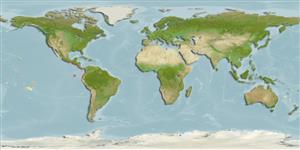Environment: milieu / climate zone / depth range / distribution range
Ecology
Marine; reef-associated; depth range 0 - 25 m (Ref. 57763). Tropical; 27°N -
Eastern Pacific: Gulf of California to Peru, including the Galapagos Islands.
Size / Weight / Age
Maturity: Lm ? range ? - ? cm
Max length : 120 cm TL male/unsexed; (Ref. 57763); common length : 60.0 cm TL male/unsexed; (Ref. 57763)
Lives in rocky, boulder strewn areas and walls. Lurks in holes, crevices and dark recesses. Constantly opens and closes its mouth, an action required for respiration, not a threat (Ref. 5227).
Life cycle and mating behavior
Maturities | Reproduction | Spawnings | Egg(s) | Fecundities | Larvae
McCosker, J.E. and R.H. Rosenblatt, 1995. Muraenidae. Morenas. p. 1303-1315. In W. Fischer, F. Krupp, W. Schneider, C. Sommer, K.E. Carpenter and V. Niem (eds.) Guia FAO para Identification de Especies para lo Fines de la Pesca. Pacifico Centro-Oriental. 3 Vols. FAO, Rome. (Ref. 9324)
IUCN Red List Status (Ref. 130435)
Threat to humans
Harmless
Human uses
Tools
Special reports
Download XML
Internet sources
Estimates based on models
Preferred temperature (Ref.
123201): 23.1 - 29.1, mean 27.3 °C (based on 229 cells).
Phylogenetic diversity index (Ref.
82804): PD
50 = 0.5010 [Uniqueness, from 0.5 = low to 2.0 = high].
Bayesian length-weight: a=0.00050 (0.00025 - 0.00101), b=3.26 (3.10 - 3.42), in cm total length, based on LWR estimates for this (Sub)family-body shape (Ref.
93245).
Trophic level (Ref.
69278): 4.0 ±0.6 se; based on size and trophs of closest relatives
Resilience (Ref.
120179): Very Low, minimum population doubling time more than 14 years (Preliminary K or Fecundity.).
Fishing Vulnerability (Ref.
59153): High to very high vulnerability (72 of 100).
Nutrients (Ref.
124155): Calcium = 25.6 [13.5, 43.4] mg/100g; Iron = 0.41 [0.24, 0.91] mg/100g; Protein = 18.8 [16.6, 21.4] %; Omega3 = 0.0915 [, ] g/100g; Selenium = 41.9 [22.3, 84.5] μg/100g; VitaminA = 54.2 [15.3, 176.3] μg/100g; Zinc = 0.891 [0.627, 1.247] mg/100g (wet weight);
